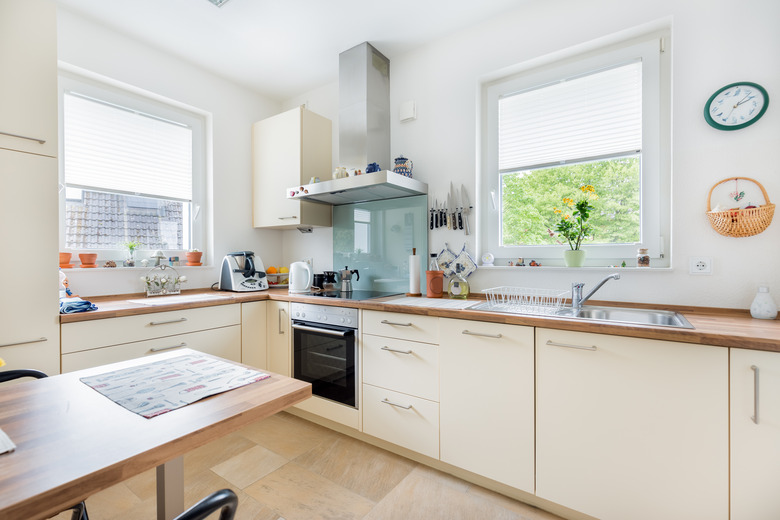How To Repair Laminate Cabinets
We may receive a commission on purchases made from links.
Laminate cabinets are made from medium-density laminate or "MDL," which is a composite core with a tough plastic glued to the front and back. This type of material is almost indestructible, but it is prone to loosening of the plastic, particularly along the edges of doors. The majority of issues are the result of faulty manufacturing, moisture penetration or incidents where the laminate hooks on fabric and pulls loose.
Two Types of Laminated Cabinets
Two Types of Laminated Cabinets
There are two types of laminated cabinets and doors. One type has a routed mortise or slot around the door or cabinet jamb. The trim molding has a "T" shape with a rounded profile. The bottom of the "T" fits into the slot to secure the strip of molding to the cabinet or door. If this type loosens, all it typically requires is a solid bump with a mallet to seat it back where it belongs.
The other type consists of a thin, ribbon-like piece of laminate glued to all four sides of doors or along the edges of cabinets. This type has a flat surface that can have a sharp edge where it's not glued securely and water penetrates or the edge hooks on something.
Evaluate for Warranty Issues
Evaluate for Warranty Issues
If the problem is extensive, such as a large percentage of the doors or edges have pulled loose, it's usually an issue with manufacturing. If the core of the door or edge of the cabinet has swelled or crumbled, it means moisture has damaged the core. Consult with the dealer for replacements or professional repairs if you're dealing with this issue.
Repairing Loose Trim
Repairing Loose Trim
If a few inches of the laminate strip or edging are pulled loose but the majority of it is intact, it doesn't need to be replaced. It's usually possible to glue the strip back on with aerosol trim cement. This type of cement is sticky and bonds on contact. It's as simple as cleaning the old glue and dirt from under the strip, spraying the cement under it and pressing it back into place.
For added security, use masking tape to maintain pressure to the repaired area. The glue bonds instantly, but it's best to leave the tape on overnight. If the glue oozes out, it can be scraped off the next day with a putty knife.
Replacing Damaged Trim
Replacing Damaged Trim
If your laminate cabinet repair is more extensive and most of the laminate is coming off the door, or part of the laminate strip is chipped, the whole piece of trim should be replaced. Heat-activated, plastic ribbon tape can be used for this purpose. It's basically laminate in strip form.
After fully cleaning old glue off the cabinet, cut the new strip with scissors, place it on the door or the edge of the cabinet, and use a hot iron to activate the glue on the back. As the glue melts, move the iron a few inches at a time until you've worked around the strip.
The tape is typically wider than needed, and it should leave a slight lip on both sides. Use a piece of folded sandpaper to remove the lip and blunt the new edges.
Dealing With Larger Surfaces
Dealing With Larger Surfaces
Laminate countertops are prone to loosening, as are door faces when moisture seeps into the joint between two pieces of laminate that meet at 90 degrees. Contact cement works best for repairing this because it bonds on contact and remains tacky.
As Pro Handyman describes, pry the loose laminate open and use a wooden block, chisel or small tool to keep the two pieces separated. Scrape old glue off the laminate and the core with a putty knife. Apply contact cement to the laminate and core, and allow it to dry to the touch — typically between 15 and 30 minutes. Carefully press the laminate back into place and use a mallet to randomly bump the laminate to bond it to the core.
If possible, add small clamps to get a better seal. Allow the cement to dry overnight and scrape off the residual glue with a knife.
Handling Gouges and Scratches
Handling Gouges and Scratches
Fill cracks, seams and gouges with a small tube of laminate seam filler. This product is specifically made to work like the existing plastic. If your repair job isn't as clean as you like and you still have hairline cracks, inject the seam filler into them. Fill seams and gouges, smooth them with a wet fingertip and allow them to dry. You can also do as HomeTips recommends and use plastic wood filler.
Making Door Adjustments
Making Door Adjustments
Laminate cabinets are typically equipped with concealed hinges. Also known as Euro hinges, they can be adjusted so the cabinet doors fit flush and flat. As Plastic Surgeon demonstrates in a video, two screws on the door side of the hinge allow the door to move left or right. Two screws on the cabinet side allow the door to move up or down. Adjust them as needed to make the doors fit better.
